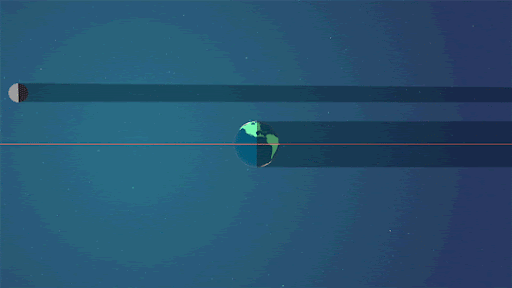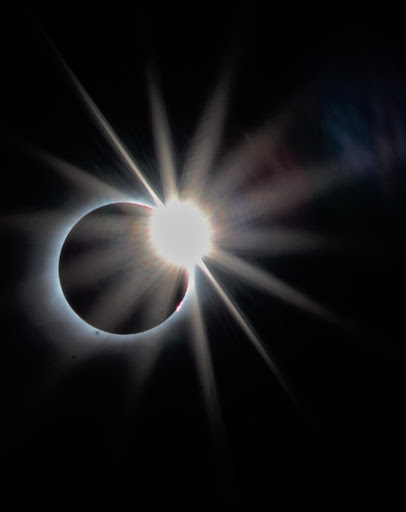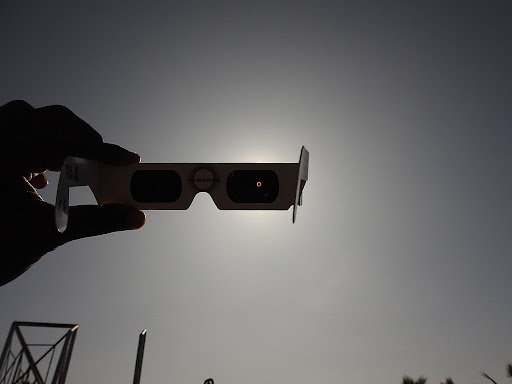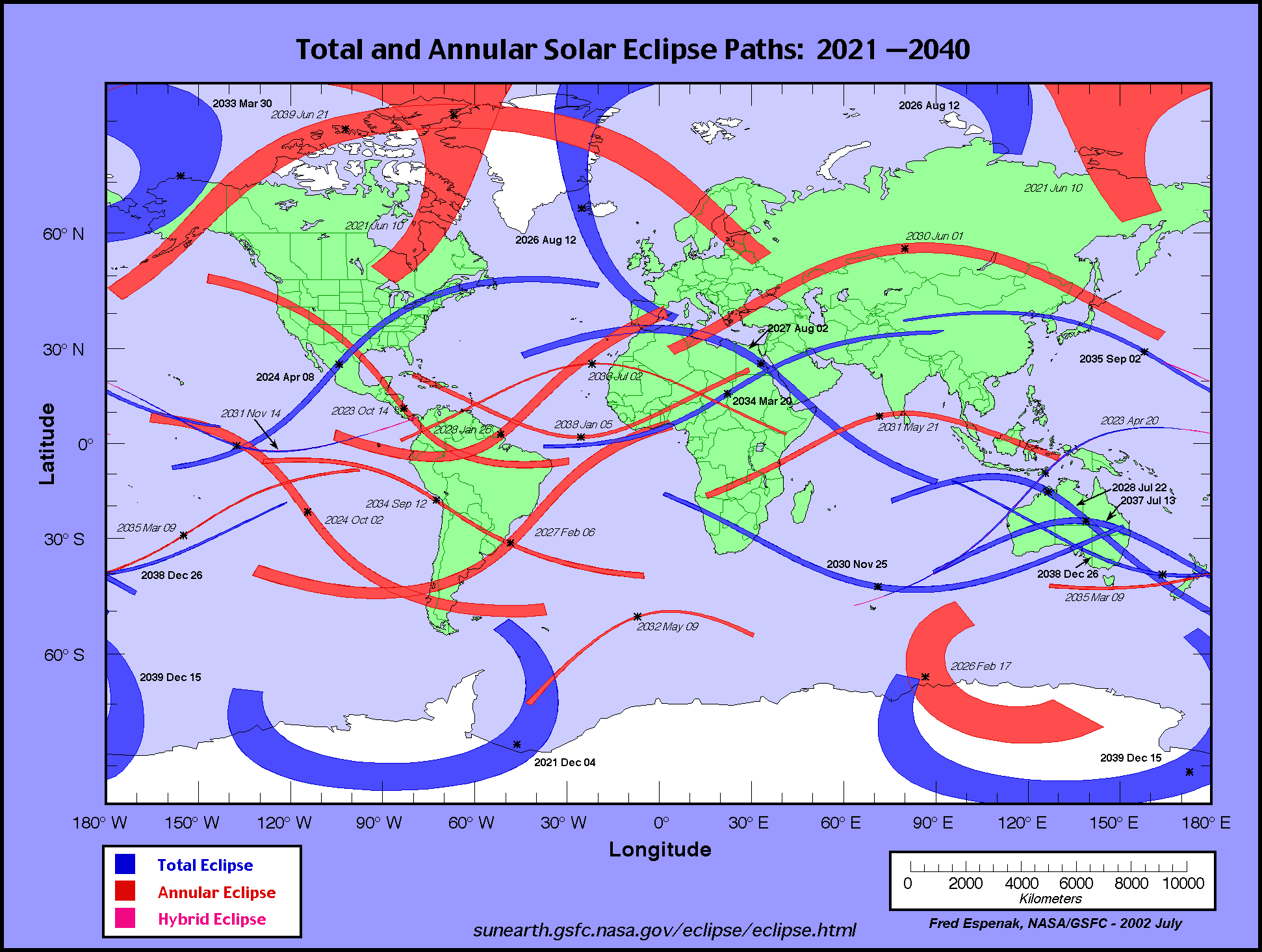Facts about solar eclipses
Before we dive right into the detail, here’s some bite size Solar Eclipse facts to get you started!
- Each year there are between 2 and 5 solar eclipses.
- The total solar eclipse, when the Moon completely obscures the Sun and leaves only the faint solar corona, is known as a Totality.
- Total solar eclipses are rare, happening only once every 18 months.
- There is another type of solar eclipse, known as a hybrid eclipse, which shifts between a total and annular eclipse depending on where you view it from on Earth. These are comparatively rare.
- The speed of the Moon as it moves across the Sun is approximately 2,250 km (1,398 miles) per hour.
- From either the North or South Pole, only a partial solar eclipse is able to be viewed.
- A total solar eclipse can last a maximum of 7 minutes and 30 seconds.
- 269 km is the maximum width of the path of totality.
- Almost identical eclipses occur after 18 years and 11 days – known as the Saros Cycle.
What Is an Eclipse?

An eclipse involves the Sun, Earth, and Moon. Sometimes, they align and cause one object to be obscured from the viewer. This is called an occultation when this object is completely hidden. However, if the passing object is much smaller, the third object is only partially hidden. This is called a transit this time.
In ancient times, people interpreted eclipses as a sign that the gods were angry. This natural phenomenon meant a bad omen for them. It came from the Latin word “eclipsis” from the Greek “ekleipsis.” Literally, this means “to fail to appear.” It also means “to leave,” and as people viewed it, it was like being “abandoned” by the gods.
Eclipses happen all the time in the solar system. Here on Earth, the eclipses that we see involve our planet, the Moon, and the Sun. Sometimes it can involve a spacecraft too. When three or more objects like these are aligned, we call it syzygy.
We get two types of eclipses, the solar and the lunar eclipse.
Solar Eclipse vs Lunar Eclipse

Solar eclipses occur when the Moon passes between the Earth and the Sun. On the other hand, lunar eclipses happen when the Earth passes between the Sun and the Moon.
The main difference between these two types of eclipses is whether the Moon or Earth passes in the middle. If the Moon is in the middle, then it’s a solar eclipse because the Sun is obscured from our line of light. If the Earth is at the center, then it’s a lunar eclipse. The Earth blocks the light from the Sun, thus casting its shadow on the Moon.
What Is a Solar Eclipse?
A solar eclipse happens when the Moon is between the Earth and the Sun. Because of that, the Moon casts a shadow on some parts of the Earth. The Sun seems to be hidden in such places for some time. It only occurs during a new moon phase when the three are aligned.
During this event, the Moon casts three types of shadows on Earth. We call them umbra, penumbra, and antumbra. These three types of shadows cause the three different types of solar eclipses that we have.

Umbra
The umbra is the dark core of the shadow of the Moon. It gets smaller as it approaches the Earth. People in the location where the umbra falls will witness a total solar eclipse.
Penumbra
The penumbra is the lighter part of the Moon’s shadow. Unlike umbra, it becomes bigger as it reaches the Earth. People will experience a partial solar eclipse where the Moon’s penumbra falls.
Antumbra
Antumbra is also a lighter part of the Moon’s shadow, but it is more like the extension of the umbra. This happens when the Moon is farthest from the Earth (apogee). Because of the distance, the umbral shadow does not reach the Earth. What reaches us instead is the Moon’s antumbra which causes an annular solar eclipse.
Why We Don’t Get Solar Eclipses All the Time

Our Moon orbits the Earth every 27 days but solar eclipses do not happen all the time. The reason for that is the Moon’s tilted orbit. It is not aligned with the Earth and the Sun all the time. Sometimes it passes above or below the Earth’s plane. There are times when it does line up and that’s when we experience a solar eclipse.
Different Types of Solar Eclipse

The different types of solar eclipse depend on how well the Moon covers the Sun in our view. Sometimes it completely blocks the Sun’s disk, sometimes only parts of it are covered.
The distance between the Moon and Earth also affects the type of eclipse that we get. But as always, looking directly at the Sun can cause eye damage. We should use a safe solar filter to witness and enjoy this memorable event.
As we know, the Sun is much bigger but the Moon can cover it entirely during a total solar eclipse. The reason for this is distance. The Sun is about 149 million km (93 million miles) away from us but the Moon is only around 384,400 km (239,000 miles).
Since the Moon is closer to us, it appears to be just the same size as the Sun. Because of that, it can completely block the solar disk when they are perfectly aligned.
However, this is not the case all the time. The Moon’s orbit is not a perfect circle so there will be times when it will be farther away from Earth. As the distance increases, it will also appear smaller so will not be able to completely cover the Sun. It’s things like these that determine what type of solar eclipse we get.
The three main types of solar eclipse are total, annular, and partial. Sometimes we get a combination of these types, called a hybrid eclipse.
Total solar eclipse
A total eclipse happens when the dark silhouette of the Moon completely covers the intensely bright light of the Sun. It occurs in places where the umbral shadow is cast. This path of the umbral shadow is called the path of totality.

Since the Earth and the Moon are moving, the path of totality moves across our planet at around 2,253 km per hour (1,400 mi per hour). Direct light from the Sun is hidden and we will experience darkness like it is already nighttime.
Only the much fainter solar corona is visible during a total eclipse. This is the only time when it is safe to look directly at the Sun because it is completely blocked.
If we get lucky, we can also spot Baily’s beads effect. Also called the diamond ring effect, it can also happen during an annular eclipse.


The Baily’s beads effect is an interesting feature before and after a solar eclipse. Just before the Moon completely covers the Sun, some beads of sunlight are still visible in some areas while not others. This is because of the rugged edge of the Moon’s surface caused by features like mountains and craters.
Annular solar eclipse
This is when the Moon and the Sun are both exactly in line. However, either the Moon is further from Earth or the Earth is closer to the Sun. When this happens, the apparent size of the Moon is smaller than that of the Sun. Because of that, it is not able to cover the Sun entirely.

The Sun then appears as a very bright ring, or annulus, surrounding the dark disk of the Moon. This annulus is often called the “ring of fire” because of its appearance. Also, because of the distance, the antumbral shadow reaches the Earth instead of the penumbra. We should wear solar filters during an annular solar eclipse.
Partial solar eclipse
This is when the Moon does not line up completely with the Sun. It only partially blocks the sunlight from reaching Earth.

Partial solar eclipses happen when the Sun, Moon, and Earth are not aligned perfectly. It can also happen when an observer is not in the path of a total or annular eclipse. If your location is outside this centerline, then a penumbral shadow will cast that area, thus causing a partial solar eclipse.
Hybrid Solar Eclipse
A hybrid solar eclipse is the rarest of the four types. It is called “hybrid” because it combines annular and total eclipse when it happens.
This kind of eclipse occurs when the umbral shadow touches some areas of the Earth’s surface but falls short on the other. Because of that, observers will see an annular or total eclipse depending on their location.

The difference is caused by the Earth’s curvature. The moon is closest in the zenith position so the umbra still reaches the surface. This results in a total solar eclipse.
However, as the Moon moves, the distance increases along the curvature of the Earth. The Moon no longer covers the Sun’s disk entirely. Also, the umbra falls short and the antumbra reaches the surface. It results in an annular solar eclipse.
Generally, it begins as an annular eclipse, then becomes a total solar eclipse along the middle section, and turns back to annular again. Sometimes, the Moon’s distance decreases as it orbits the Earth. When that happens, it starts as an annular eclipse then turns into a total eclipse. This time, however, it will not switch back to annularity.
Safety Reminders
Solar eclipses are an exciting event. However, we should always practice caution. Even though the Sun is partially blocked, its rays are still harmful to our eyes. Never look at it directly because it can damage your retina or even cause blindness.

The only time it is safe to look directly at the Sun is during a total solar eclipse because it is completely obscured. During annular, partial, or even hybrid solar eclipses, we have to use a Sun filter or eclipse glasses. We can also use a number 14 welder’s glass instead.
Do not use regular sunglasses or even homemade filters. Also, it is not good to look at it through cameras, binoculars, and even telescopes. If you use solar filters, make sure to check for damage. where you can see any scratches on it, use another one instead.

If you do not have any solar filters or eclipse glasses, you can still observe this amazing event by using a pinhole projection. We can also magnify the Sun in our projection using a pair of binoculars. We will only use it for magnification, not for direct viewing. It does not filter out the Sun’s rays so it does not protect us from retinal burns.
Solar Eclipses in 2024
In 2024, a total eclipse in April will be observed over the continental US, the eastern part of Canada, and Mexico. Totality will last for about 3 to 4 minutes depending on location. It will be observed partially in some places in North and Central America. On October 2, an annular event will be observed in Chile and Argentina. A partial solar eclipse will fall around the Pacific and other areas of South America.
NASA has made a guide to help us see the path that these solar eclipses will take in the coming years.

More Solar Eclipse Facts
- We experience darkness when the Moon completely blocks the Sun. This state is called totality. As a result of the movements of the Moon and Earth, it does not last very long. The longest duration is around 7 and a half minutes. However, it will take about one hour for normal daylight to return.
- A solar eclipse causes a lot of strange changes around us. As totality approaches, the temperature drops, the breeze disappears, and shadows will look different than they usually do.
- They affect animals in strange ways. Animals return to their houses thinking that it is already night time and it’s time to sleep. Nocturnal animals like bats also come out during totality. This momentary darkness confuses them, causing them to just go back to what they were doing after the Sun comes out again.
- Of the four types of eclipses, partial solar eclipses occur most frequently (35%). Annular and total solar eclipses have a 33% and 27% chance of happening respectively. Hybrids, however, only have a 5% chance of occurring.
- A total number of 224 solar eclipses will happen in the 21st century. Only seven are hybrids, 68 will be totals, 73 are annulars, and 77 are partials.
- Hybrid solar eclipses are so rare that only seven eclipses of this type occur in this century. These are in the years 2005, 2013, 2023, 2031, 2049, 2050, and 2067.
- During totality, we can use the other objects in the sky as our sources of light. The other stars and planets become more prominent during this time without the bright Sun.
- A total solar eclipse cannot be observed from the North Pole and the South Pole.
- The solar eclipse on May 29, 1919, served as an important event that helped prove Albert Einstein’s theory of general relativity. Astronomers Arthur Eddington and Frank Watson Dyson organized expeditions to observe the eclipse from different places. It became known as the Eddington Experiment.
- The closest planets to the Sun, Mercury and Venus, do not experience an eclipse because they do not have moons. Still, these two planets can transit across the Sun.
- In about 600 million years from now, the Moon will move farther away from Earth and it will appear smaller in the sky. Because of that, there will be no more total solar eclipses.
Source:
(https://earthsky.org/earth/lunar-solar-eclipse-animals/)
(https://travelquesttours.com/blog/solar-eclipses-types-total-annular-partial-hybrid-solar-eclipse/)
https://www.timeanddate.com/eclipse/hybrid-solar-eclipse.html
https://eclipse.gsfc.nasa.gov/SEdecade/SEdecade2021.html
https://www.nsc.org/home-safety/tools-resources/seasonal-safety/solar-eclipse#:~:text=The%20only%20safe%20way%20to,electronics%20supply%20outlets%20and%20online.
(https://www.crowdynews.com/blog/solar-eclipse-fun-facts/)
Image Sources:
Eclipse: https://www.nasa.gov/sites/default/files/styles/full_width/public/thumbnails/image/m17-092.jpg?itok=aT8pAGcO
Lunar vs solar eclipse: https://cdn.britannica.com/30/91230-004-6E0EA502.gif
Solar eclipse shadows: https://i.pinimg.com/564x/7c/25/60/7c25603b58b41fc92af578faa43c041a.jpg
Why We Don’t Get Solar Eclipses All the Time: https://64.media.tumblr.com/d33e05b04698c39a68e99f035a542086/8a8de5e2ffd0d95e-2b/s540x810/376ddb903b74b3bd3a5ddd91f4dd04c3ea59cff0.gifv
Baily’s beads: https://upload.wikimedia.org/wikipedia/commons/thumb/6/6b/August_21_2017_solar_eclipse_baily_beads_TLR2.jpg/465px-August_21_2017_solar_eclipse_baily_beads_TLR2.jpg
Diamond ring effect:
https://upload.wikimedia.org/wikipedia/commons/thumb/a/ae/Exit_Diamond_Ring_Effect.jpg/800px-Exit_Diamond_Ring_Effect.jpg
Annular: https://live.staticflickr.com/7216/7244982704_64f40934c1_b.jpg
Partial: https://live.staticflickr.com/2612/3744366285_03177dcd1b_b.jpg
Hybrid: https://c.tadst.com/gfx/900×506/hybrid-solar-eclipse.png?1
Eclipse glasses: https://upload.wikimedia.org/wikipedia/commons/thumb/b/bb/Annular_Solar_Eclipse_in_Jaffna_-_26_December_2019_%288%29.jpg/1024px-Annular_Solar_Eclipse_in_Jaffna_-_26_December_2019_%288%29.jpg
Pinhole projection: https://64.media.tumblr.com/71d6776bf4f38f49f68c5de59d220243/tumblr_inline_oubjsfrwws1tzhl5u_1280.png
Solar Eclipse Path: https://eclipse.gsfc.nasa.gov/SEatlas/SEatlas3/SEatlas2021.GIF